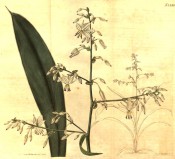Arthropodium cirrhatum R.Br.
Frost-hardy, tufted, rhizomatous, evergreen perennial with lance-shaped leaves and nodding, star-shaped white flowers, flecked purple and yellow, in lax panicles, in early summer. To 90cm. [RHSE, Hortus].
Horticultural & Botanical History
‘Native of New Zealand, where it was discovered by Sir Joseph Banks and Dr. Solander, in their celebrated voyage to the South Seas and round the world, with Captain Cook. Has been treated as a greenhouse plant, but Mr. Milne thinks it may prove hardy.’ [BM t.2350/1822]. Introduced to Britain in 1821. [JD]. The fleshy roots are used medicinally by the Maoris. [BR f.709/1823].
History at Camden Park
Listed in all published catalogues [B.45/1843]. Possibly obtained from John Bidwill.
Notes
Published Dec 31, 2009 - 12:49 PM | Last updated Jan 07, 2010 - 01:24 PM
| Family | Anthericaceae |
|---|---|
| Category | |
| Region of origin | New Zealand |
| Synonyms | |
| Common Name | Renga Renga lily |
| Name in the Camden Park Record | Arthropodium cirrhatum |
| Confidence level | high |
